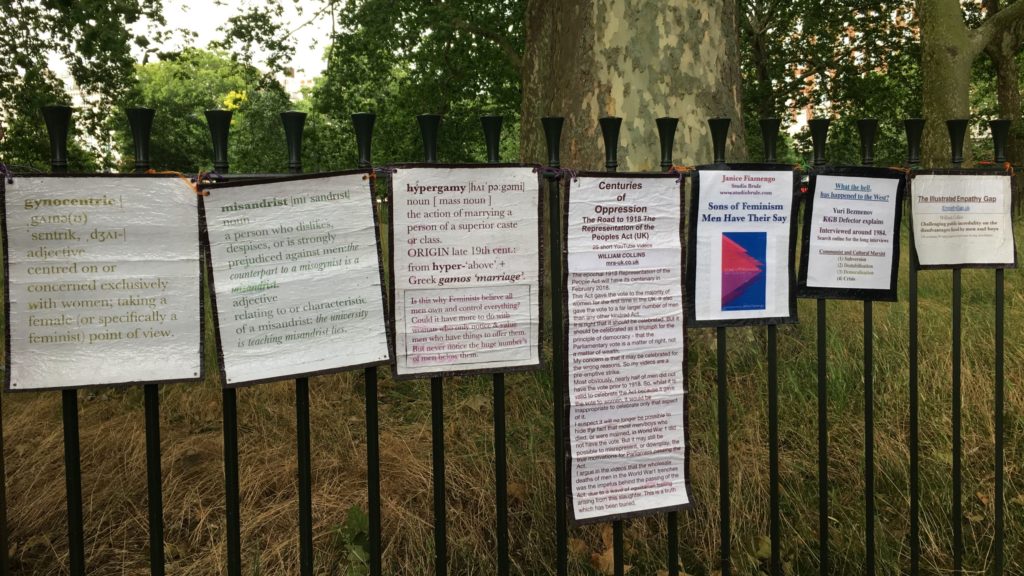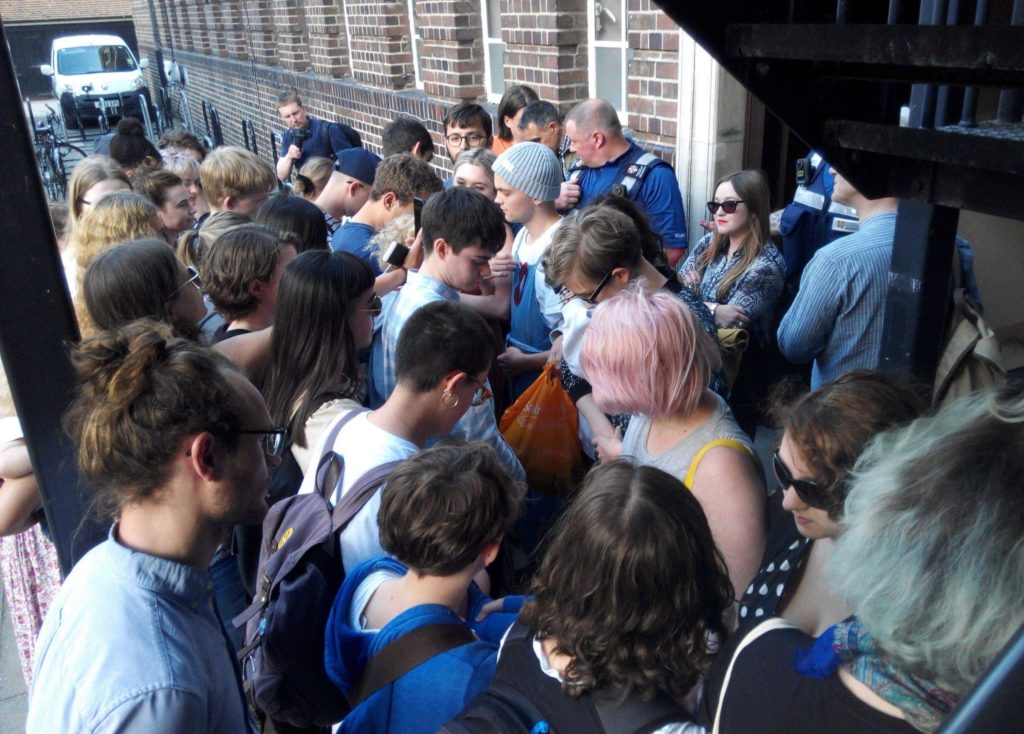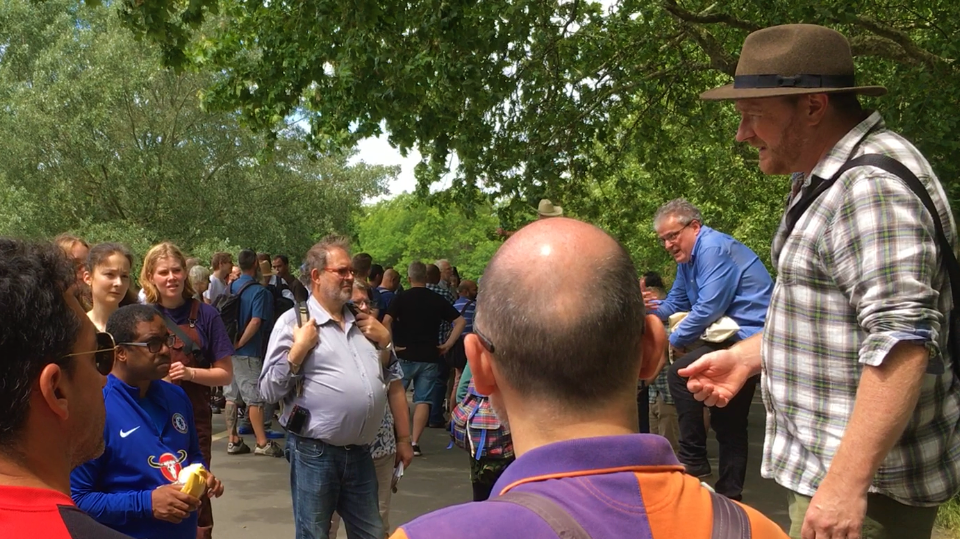There’s a growing narrative that the right to free speech is just an excuse for bigotry. Should controversial men’s rights activists be allowed to express their views?
As the glass smashed over his friend’s head, Rod lurched forward to help. The crowd surrounded him instead, and he was struck repeatedly from all sides.
Rod fractured his hand defending himself, but many of the assaulted men, some in their sixties, didn’t immediately match violence with violence. They chose the more passive path of getting their phones out to document the attack.
During a lull in the violence, a masked woman can be seen trying to goad Rod, “Hit me bitch, hit me,” she repeats. Rod refuses.
Meanwhile, a staff member in the London Wetherspoons is approached by one of the assailants, who claims that the fight had started because Rod and his friends had hit a woman.
The anti-far-right political protest group, Antifa, had perpetrated the attack. Although they often receive positive media attention, Antifa don’t shy away from using violence against the organisations that they oppose.
Rod was upset by the accusation he’d started the fight by assaulting a woman. “No one of us hit a woman, rather insane thing to even consider,” he said, “I didn’t even know she was hitting me from behind all the men!”
The crime that Rod had committed was attending the 2018 March for Free Speech, organised by controversial right-wing figures such as the notorious Tommy Robinson and former Breitbart senior editor Milo Yiannopoulos. Rod and his friends had gone for a drink in that fateful Wetherspoons after the event.
Beyond attending the march, there may be another reason that Rod and his companions were targeted.
On alternate Sundays, they talk about men’s issues at Speakers Corner in Hyde Park. It’s a place emblematic of one of western democracy’s founding principles: free speech. Speakers stand on soap boxes, or in this case, ladders, and address whomever is willing to listen about whatever issue they feel compelled to address. For Rod’s friends, it’s speaking about areas in which they feel men’s rights are being infringed.
When the #MeToo movement has reminded us that we still have a long way to go with equality for women, should these controversial men’s rights activists – MRAs – be allowed to voice their opinions?
On a sunny Sunday morning, Rod stood atop his two-step ladder and began to address the fleeting crowd. It was early for a Sunday. The speakers were warming up, and the crowd was made up of dribs and drabs of passers-by.
A cyclist in his early thirties stopped and scanned the laminated signs that Rod had attached to the fence behind where he speaks. “Justice for men and boys,” he jeered, pointing to his friend.
“Come and have a chat,” said Rod.
“Nah, you’re alright,” the man replied in a thick north-western accent, “Justice for white males.”
The reaction from this passer-by hinted at the controversy that enshrouds Rod and his companions: they’re not fond of feminism.

The men’s rights movement is defined as much against feminism as it is for men’s rights according to advocacy group, Hope Not Hate, in their State of Hate report providing a guide to the contemporary far-right landscape.
MRAs fall within the so-called ‘manosphere’, an umbrella term that the report’s author, Simon Murdoch, explains as a loosely affiliated collection of online media dealing with men’s issues. Murdoch also elaborates on where the manosphere problem lies. “[It’s] oriented around an opposition to feminism and, within parts, [an] embrace of extreme misogyny.”
Murdoch acknowledges the murky mixture of anti-feminism, men’s issues, and the combination of the two. “Whilst many of its interests and ideas are inherently sexist, anti-feminist and misogynistic, others, such as concerns about male suicide, are not themselves expressions of these. Rather, they are viewed in the manosphere through a lens which places the blame for such issues at the feet of women, feminism and progressive politics.”
Manosphere culture is largely confined to the internet, and the fighting between different factions prevents too much political growth. However, Murdoch points out that MRAs might be different. “The exception to this are men’s right’s activists, in part because they employ a framework – however misguidedly – of human rights activism.”
In the report, Hope Not Hate profile the political party, Justice for Men and Boys. Founded by ex-conservative consultant, Mike Buchanan, the party seeks to address what it sees as injustices against males.
Elizabeth Hobson is director of communications for Justice for Men and Boys. The outspoken female MRA defends their anti-feminist stance. “Feminism is a massive barrier in front of us getting the recognition for men and boys’ issues: getting them to be taken seriously,” she said. “But feminism is so powerful that some people decide nothing’s really going to change until people face up to the reality that this movement, which dominates mainstream media and politics, maintains its kind of dominance.”

An opposition to feminism because it’s a barrier to legitimate men’s issues being taken seriously could be questionable. The 80-page Justice for Men and Boys manifesto includes a call to end positive discrimination towards women in boardroom appointments, and proposals to reduce the term limit for legal abortions.
The MRAs’ openly anti-feminist rhetoric strikes a serious blow to their credibility, but they argue that they’re fighting fire with fire.
MRAs such as Hobson maintain that they’re just voicing dissent against an overly dominant ideology. “In certain fields, particularly the social sciences and the arts and humanities, they’ve gone from being left-leaning,” she said, “Whereas now the balance is so far dominated by these left-wing ideologies that there’s no room for dissent. And there is none to reign in the kind of, excesses. I think it’s not just gender politics, but gender politics is certainly part of it.”
There is evidence to suggest Hobson might be onto something. Three American academics James A. Lindsay, Peter Boghossian, and Helen Pluckrose wrote 20 articles under a false name in the field of study they named grievance studies. The point was to show that the academy is not always so scrupulous in what it publishes.
Fourteen were accepted, and four ultimately published before the ruse was uncovered.
“There was a bit of Mein Kampf where they’d just taken Jews out and put in men,” said Hobson, which got peer-reviewed and submitted to an academic journal and published.”
Hobson tried to provide an alternative voice to the dominant ideology she describes by giving a speech at Cambridge University this May, entitled, ‘The history of feminism’. Before it could go ahead, an open letter urging the talk to be cancelled was sent to the university’s vice chancellor and signed by over 500 students, faculty members and alumni.

Hobson explained the situation from her perspective. “The first we knew about it was when their Varsity student newspaper published excerpts from an open letter,” she said, “Which had these kinds of absurd allegations that Justice for Men and Boys had harassed members of the Cambridge community, and that we were misogynists.”
The letter makes accusations of harassment, but stops short of providing any details. “I was talking to the students and asked if they could show me any evidence of harassment or misogyny,” said Hobson. “Not one! Not one even tenuous link.”
On the Justice for Men and Boys website there are links to all of their previously published articles. Some of these articles reference Cambridge academics, criticising research or points they’ve made during public engagements. The language used is sometimes childish, even offensive, labelling people, ‘whiney feminist of the month.’
This may be the harassment that the letter refers to. Whatever the case may be, fresh accusations of harassment surfaced in May 2019.
When Hobson and her companions were enjoying a drink in Wetherspoons before the event, a protester allegedly accompanied by a photographer for the student paper Varsity attempted to douse them in milkshake.
This wasn’t the end of the confrontation. Protesters clashed with attendees at the talk, leading to serious allegations of assault from both parties.
It could be that the university protesters were right to be fearful of the talks, and that as they’d claimed in their open letter, allowing men’s rights activists onto their campus had created an unsafe environment.
Still, the clash at Cambridge involved violence that can’t be solely attributed to MRAs. They were blamed and vilified all the same.
This may explain why Rod was very wary of talking openly with a journalist. He described the group of speakers as easy targets.

This targeting behaviour may go beyond genuine outrage at their ideas. Hobson argued that there is another motive. “With call-out culture,” she said, “It’s about group dynamics and about rising in the hierarchy in your group.”
Status-seeking in a group is key to the idea of toxic masculinity. Toxic masculinity isn’t all that well defined, but it’s used broadly to describe different aspects of traditional male behaviour that are negative.
“I read male feminist literature a lot of the time and what I hear is all men are pigs, but I’m better than that,” said Hobson. “They’re trying to climb their own dominance hierarchy basically. Its toxic masculinity in action.”
Rod seems to agree with Hobson’s interpretation. “Some male feminist can actually be the worst,” he said, “They expect women to be grateful that there are male feminists.”
Others say it’s just about making the world a better place by combating prejudice. “Many feminist activists are doing brilliant, vital work countering the manosphere,” wrote Murdoch. “Not only is it essential that we fight for the feminist cause for its own end, but as we are increasingly seeing, sexism, anti-feminism and misogyny are acting as a prominent route into the wider far-right.”
It may not always be entirely altruistic though. Psychologist John Haidt compares call-out culture with tribal behaviour. Hobson explained his analogy. “He equates it to practices of some tribe where the young men get prestige by collecting heads,” she said. “People being scalped because if you can bring someone down over some perceived slight then it makes you look like a more virtuous, better kind of person within this small group.”

There’s an argument that MRAs themselves promote a toxic culture. Murdoch describes the manosphere as whole as having a deeply conspiratorial worldview, which can fan the flames of bigotry. “By promoting the idea that feminism is an authoritative, controlling ideology MRAs create room for sexism and misogyny to be legitimised through the undermining of feminist reform.”
Hope Not Hate may be right that MRAs promote misogyny, but MRAs might be just part of the societal problem. Elizabeth continued her analogy between callout culture and tribal head-hunters. “If there are no strangers around and they really need a quick boost to their status, they’ll go for someone from within their community.”
The MRAs seem to argue that there’s a one-sided story with them as the targeted enemy, but promoting a one-sided narrative is typically confined to the MRAs according to Hope Not Hate. They say that MRAs spread propaganda. “MRAs follow the current far right trend of presenting themselves as martyrs for free speech,” wrote Murdoch, “Censored for merely trying to speak the ‘truth’ about ‘dangerous’ progressive ideas, while they are in reality aiming to propagandise.”
One post available on Justice for Men and Boys website that might be considered harmful propaganda was cited in the open letter calling for the talks to be cancelled. The article entitled, ‘13 reasons why women lie about being raped,’ is enough to raise hairs on any arm.
The open letter claimed that the article promotes a victim-blaming culture, echoing Hope Not Hate’s view that MRAs’ ideas create room for sexism and misogyny to be legitimised.
Hobson sought to add some context. “This article has quite a click-baity headline, but if you read it, it’s not only written by a woman, but it’s basically a call for due process. And it’s a response to the feminist insistence that women just don’t ever lie about being raped.”
Signatories of the open letter maintain that the piece is inherently misogynistic. Hobson argues that it isn’t. “Although it sounds a bit harsh and is certainly polemical, at least in its title,” she said, “It’s not a misogynistic piece of writing.”
The extremely serious, and sensitive, issue of sexual assault aside, some MRA concerns are founded on legitimate societal concerns. Some of the statistics Rod relies on in his talks at Speaker’s Corner are little disputed, such as the fact that the rough sleeping population is overwhelmingly male.
They aren’t debates that are happening in universities or on TV. The situation can be resolved if we do actually start having debates with these people.”
Ewan Jones
But criticisms of MRAs don’t always come from what they say, so much as the way they say it.
The Southern Poverty Law Center – SPLC – is an NGO fighting hate and bigotry. Arthur Goldwag of the SPLC doesn’t deny all the MRAs’ concerns. “While some of them voice legitimate and sometimes disturbing complaints about the treatment of men, what is most remarkable is the misogynistic tone,” he wrote. “My criticism was not about the notion of men’s and fathers’ rights per se, but the often heavily misogynistic tone of many MRAs — a tone that went well beyond criticism of the family court system, domestic violence laws, and false rape accusations and that in some cases verged on violence.”
Still, it seems legitimate men’s issues don’t always get taken seriously even when voiced in an acceptable way. In Parliament in 2015, men’s issues as a subject of debate were laughed at.
Philip Davies MP suggested a debate on International men’s day around men’s issues, including the high suicide rate and unreported domestic violence. Jess Philips MP burst out laughing at his request, stating men’s issue can be debated anytime.
In fact, the government had already denied a debate in the House of Commons. Still, Philips stance was clear. “When I’ve got parity, and when women in these buildings have got parity, you can have your debate.”
There might be a logic to Philips’ argument, but according to Rod her delivery is a problem. “Every time Jess Phillips’ head comes on the telly we get more people on the men’s rights movement. Her smirk, her snarling and gloating attitude.”
Philips confrontational tone may not equal the aggression of MRAs, but it seems debate around the legitimate men’s issues might not always be given an airing.
Denying people a platform to voice their opinions might be making the situation worse. MRA Ewan Jones, who has been banned from YouTube for promoting populist ideas, may or may not be the best advocate for free speech, but he blames the internet for the growth of more extreme ideas. “They aren’t debates that are happening in universities or on TV,” he said, “The situation can be resolved if we do actually start having debates with these people.”

According to the MRAs their issues are not acknowledged in academia either. “The academics are all feminists, they’re intersectional,” said Rod. “Everything they’ve learnt is one-sided. They call it the feminist lens, I call it the feminist lens cap. Basically, you’re looking at a dogma. If you want to look at humanity, you want something binocular.”
It seems there’s a chicken-egg argument over whether MRAs should be denied speech because they’re hateful, or whether they’re hateful because they’re not allowed to speak.
According to the Anti-Fascist Network, they’re not about telling people what to do. They claim to be a network of independent groups working together against the rise of racism and fascism.
Rod holds a very different opinion about Antifa. “It is a global Western internal terrorist movement.”
In Antifa’s account of the events at the Day for Freedom march, they claim they were attacked by Tommy Robinson supporters, and only acknowledge violence on their part as a reaction.
But in at least one instance involving Rod and his friends, it seems the situation is not so black and white with more nuance to the truth than just one side of this debate.
Whether MRAs should be allowed to speak depends to which side of the fence you pose the question. It may be that they’ve forgone that right by crossing a line, but as Hobson said, there needs to be a left-wing, right-wing balance in the search for truth.
